The U.S. Navy posted an image on Twitter of the USS Minnesota, the 10th Virginia class nuclear fast attack submarine, congratulating its crew for earning the Meritorious Unit Commendation. The image shows sailors atop the sub’s conning tower and has some interesting details, but the weapon that one of the submarine’s crewmen is holding really stands out.
Submarines are at their most vulnerable when transiting on the surface in busy waterways. As such, force protection is critical in order to shield them from everything from explosive-laden boats to drones. When just a number of seconds can mean the difference between a possible threat and an imminent attack, having a less-than-lethal option for deterring nearby potential threats and repelling actual attacks is highly valuable. Enter the laser dazzler.

These light projection devices fire highly powerful and sometimes modulated laser beams with pinpoint precision over long distances. The idea is they will temporarily blind and disorient an attacker, or even the electronic optics being used by a threat. What you can’t see you cannot attack, or at the very least the disorienting nature of the dazzler will buy precious seconds to better assess the situation and apply lethal force, if necessary.
The weapon we see in this image is the B.E. Meyers Glare LA-9/P. The manufacturer’s website describes the system as such:
For long-distance hail and warning, especially during maritime security, the GLARE® LA-9/P combines a powerful green beam with Eye Safe® technology. The laser rapidly determines if an unintended observer is within the nominal ocular hazard distance (NOHD) and immediately shuts off the glaring output to prevent accidental eye injury. Once the bystander has moved out of the NOHD, the laser output instantly resumes.
Warnings can be sent out to 4 km at night and 1.5 km during daylight. Offensive glaring is achievable out to 500m to hinder and prevent further aggression. In theater, GLARE lasers have been proven to save lives of both civilians and soldiers by providing a rapid warning method across cultural and linguistic boundaries.
The main idea behind the system is that it modulates its output based its range to the target via using an internal laser range-finder. Thus the maximum eye-safe setting can be used throughout the engagement. This is also important because international law prohibits the employment of any such system that is deliberately designed to cause permanent blindness.

A Navy fact sheet on what it calls ‘non-lethal optical distractors’ reads:
Non-lethal optical distracters are visible laser devices that have reversible optical effects on human targets. These types of non-blinding laser devices use highly directional optical energy to support several non-lethal capabilities, including:
• Temporarily overwhelming an adversary’s visual sense by emitting a credible glare source
• Providing an unequivocal, non-verbal warning
• Providing the target an opportunity to clarify intent
Although these capabilities are generic to any high-intensity light source, laser light sources are ideal for non-lethal applications, as the optical energy is collimated and very directional. This allows the user to precisely deliver the optical energy to a target at long ranges, while minimizing the total power output of the device and minimizing collateral effects to other bystanders.

While defending checkpoints and disorienting potential threats during raids are major applications for these weapons, you can see how well suited they can be to protecting vulnerable maritime assets, too. At the very least, they can make it clear to nearby boaters and pilots that they shouldn’t come closer without having to communicate audibly, by radio, or by firing actual warning shots.

With suicide and unmanned vessel attacks being among the biggest potential threats to ships these days, laser dazzlers offer an essential layer of protection. Even lower-end drones, whether airborne or waterborne, could be repelled via dazzlers by blinding their electro-optical systems. The ability to pinpoint the laser’s aim is why they are mounted on a rifle stock that is also equipped with a scope.
The Navy has deployed these systems on many of its ships, including its aircraft carriers, but the service is already fielding a far more powerful, hard-mounted, laser dazzler that will have a much greater range and a better ability to blind more advanced electronic optics. Named ODIN, it’s already deployed on one of the Navy’s destroyers and will be on seven more in just three years.

Laser dazzlers are becoming increasingly common among other militaries around the world, as well. China, in particular, has embraced them to a high degree, and they have used them against U.S. assets in troubling ways.
When it comes to lasers on submarines, there was a recent report that U.S. submarines may receive a laser mast of some sort in the future. Although some conjecture was likely overblown as to what is feasible in terms of such a system’s capabilities, it would likely only be able to engage drones and small craft, if at all, and more likely it would be a dazzler system similar to ODIN.
Also seen in the picture of the Minnesota that the Navy posted is the submarine’s dual AN/BVS-1 photonics masts. Unlike traditional periscopes, these do not penetrate the main hull. Instead, they send their electro-optical and infrared video and imagery to the sub’s control room digitally. This allows the control room to be placed lower in the main hull on the Virginia class as the periscopes don’t have to reach it physically.

The system has high-power infrared and electro-optical cameras, a laser rangefinder, as well as a modular top unit that can be swapped out with electronic warfare, electronic surveillance, and communications payloads. The mast is coated in radar-absorbent material and is designed to avoid detection when extended.
So, the big takeaway here is if you are sailing near a U.S. Navy warship and suddenly get hit with a green beam of light, turn around. The next opportunity to pull away may come via a burst from a machinegun, or not at all.
Contact the author: Tyler@thedrive.com
